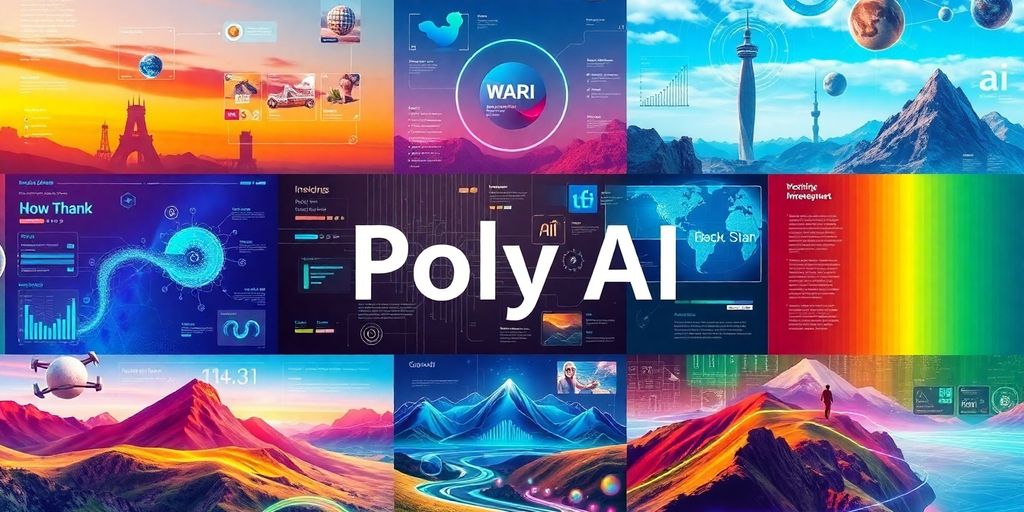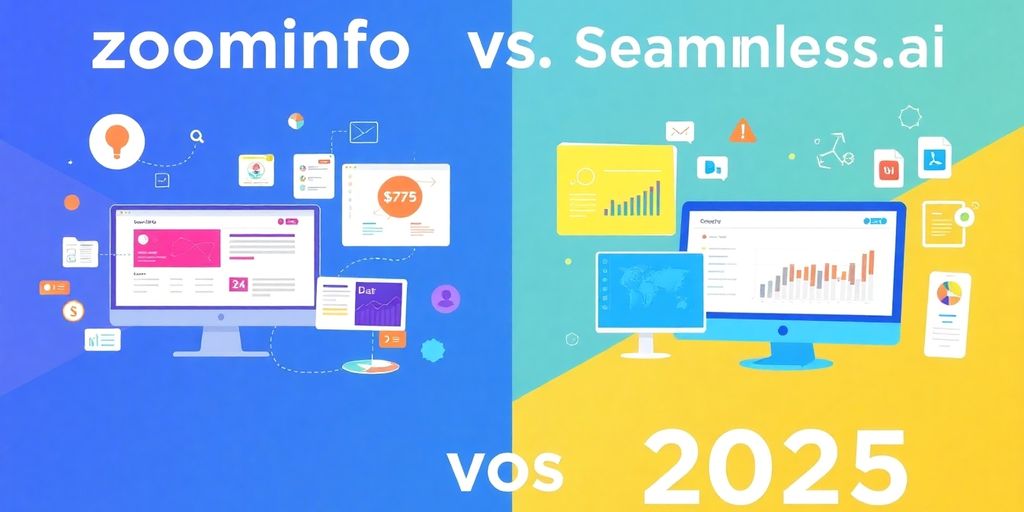Last updated on May 26th, 2025 at 07:09 am
As we step into 2025, the demand for conversational AI solutions is on the rise. Businesses are looking for ways to enhance customer interaction and streamline communication.
Poly AI has been a popular choice, but it’s not the only option out there. In this article, we are explore various websites like Poly AI that offer unique features and benefits to meet your specific needs.
Whether you’re searching for comprehensive platforms or free alternatives, we’ve got you covered with some great choices to consider.

Key Takeaways
- Poly AI is a strong player in conversational AI, but alternatives can offer unique benefits.
- Kore.ai provides a no-code platform that makes chatbot creation easy for everyone.
- Jotform AI focuses on user-friendly features, making it ideal for businesses of all sizes.
- Free AI tools can be useful, but they often come with limitations.
- Choosing the right AI solution depends on your specific business needs and long-term goals.
Exploring Conversational AI Platforms

Understanding Conversational AI
Conversational AI is becoming a big deal, and it’s not hard to see why. It’s all about making computers talk to us like humans, which can seriously change how businesses work. Think chatbots that actually understand what you’re saying, not just spitting out canned responses. It’s more than just fancy tech; it’s about making interactions smoother and more natural.
Conversational AI is changing the game by automating customer service, streamlining internal communications, and even helping with sales. It’s not just about replacing humans, but about making their jobs easier and more efficient.
Key Features to Look For
When you’re checking out conversational AI platforms, there are a few things you really need to keep in mind. You want something that’s easy to use, can handle a lot of different situations, and plays well with your other systems. Here’s a quick rundown:
- Natural Language Processing (NLP): This is what lets the AI understand what people are saying, even if they don’t use perfect grammar.
- Machine Learning (ML): The AI should be able to learn from past conversations and get better over time.
- Integration Capabilities: It needs to work with your existing CRM, help desk, and other tools.
- Customization Options: You should be able to tweak the AI to fit your specific needs and brand.
Benefits of Using AI Platforms
Using AI platforms can bring a ton of advantages to your business. The biggest one is probably saving time and money. But there’s more to it than that. Here are some key benefits:
- 24/7 Availability: AI doesn’t need sleep, so you can offer customer support around the clock.
- Improved Customer Satisfaction: Quick, accurate responses make customers happy.
- Increased Efficiency: Automate repetitive tasks and free up your human employees to focus on more complex issues.
- Data-Driven Insights: AI can analyze conversations to identify trends and areas for improvement.
Innovative Alternatives to Poly AI
Kore.ai: A Comprehensive Overview
Kore.ai stands out as a strong contender in the conversational AI space. It’s designed to help businesses automate interactions across various channels.
I’ve been reading up on it, and it seems like Kore.ai’s strength lies in its enterprise-grade security and compliance features, which are super important these days. It also offers a low-code platform, which means you don’t need to be a coding whiz to build and deploy AI assistants.
- Multi-channel support (web, mobile, messaging apps)
- Pre-built industry solutions
- Advanced analytics and reporting
Jotform AI: Features and Benefits
Jotform AI is interesting because it brings AI into the form-building process. It’s not just about chatbots; it’s about making data collection smarter.
I think Jotform AI could be a game-changer for small businesses that rely heavily on forms for everything from customer feedback to order processing. It can automatically generate forms based on your descriptions, which saves a ton of time.
I’ve heard that Jotform AI’s ability to analyze form responses and provide insights is pretty impressive. It can help you identify trends and patterns in your data, which can inform your business decisions.
Airtable AI Assistant: Unique Offerings
Airtable AI Assistant is all about bringing AI into your data management workflows. If you’re already using Airtable, this could be a no-brainer. It helps you summarize records, generate content, and even translate text, all within your Airtable bases. It’s like having a little AI helper right where you need it.
Here’s a quick comparison:
| Feature | Airtable AI Assistant | Other AI Tools |
|---|---|---|
| Data Integration | Seamless | Varies |
| Content Generation | Yes | Limited |
| Summarization | Yes | Limited |
Free Options for AI Solutions
Top Free Alternatives to Consider
Finding the right AI solution doesn’t always mean breaking the bank. Several free alternatives offer impressive capabilities, especially for smaller projects or businesses just starting to explore AI.
These options often provide a great way to test the waters and see how AI can fit into your workflow without a significant financial commitment. Let’s explore some of the top contenders:
- Dialogflow: A Google product, Dialogflow offers a free tier suitable for building basic chatbots and conversational interfaces. It’s a solid choice if you’re already integrated with Google’s ecosystem.
- Rasa Open Source: For those who prefer more control and customization, Rasa provides an open-source framework. While it requires more technical expertise, it allows you to build sophisticated, context-aware assistants.
- Microsoft Bot Framework Composer: This tool offers a visual canvas for designing bots, making it accessible to users with varying levels of coding experience. The free tier provides ample resources for experimentation and development.
Limitations of Free AI Tools
While free AI tools are attractive, it’s important to understand their limitations. Free tiers often come with restrictions on usage, features, or support. For example, you might encounter:
- Limited API Calls: Many free AI services restrict the number of API calls you can make per month, which can be a problem for high-traffic applications.
- Feature Restrictions: Advanced features, such as sentiment analysis or multilingual support, may only be available in paid plans.
- Watermarks or Branding: Some free tools add watermarks or branding to your outputs, which may not be suitable for professional use.
It’s crucial to carefully evaluate the limitations of any free AI tool before committing to it. Consider your long-term needs and whether the free tier will continue to meet them as your business grows. Otherwise, you might want to consider Replica Studios for AI voice acting.
How to Choose the Right Free Tool
Choosing the right free AI tool depends on your specific needs and technical capabilities. Here are some factors to consider:
- Identify Your Goals: What do you want to achieve with AI? Are you building a chatbot, automating tasks, or analyzing data?
- Assess Your Technical Skills: Are you comfortable with coding, or do you prefer a visual interface?
- Evaluate Scalability: Can the free tool handle your expected usage volume and data size?
Prioritize tools that align with your goals and skill set. Don’t be afraid to experiment with different options to find the best fit. Remember to check for community support and documentation, as these can be invaluable resources when you’re getting started. Also, consider the integration capabilities with your existing systems.
Evaluating AI Platforms for Business Needs
Assessing User Experience
When you’re checking out AI platforms, don’t just look at the fancy features. User experience is super important. Is the platform easy to use for both your team and your customers? A clunky interface can lead to frustration and wasted time, which defeats the purpose of implementing AI in the first place.
Think about how intuitive the design is, how easy it is to train the AI, and how smoothly it integrates into your existing workflows. A good user experience means faster adoption and better results. You should also consider:
- Ease of navigation
- Clarity of instructions
- Availability of tutorials and support
Integration Capabilities
One of the biggest headaches with new software is how well it plays with your existing systems. Can the AI platform connect with your CRM, your email marketing tools, and your other essential business applications? If not, you’re looking at a lot of manual data transfer and potential errors.
Seamless CRM integrations are a must-have for most businesses. Look for platforms that offer robust APIs and pre-built integrations with the tools you already use. This will save you time, money, and a whole lot of frustration. Consider these points:
- API availability
- Pre-built connectors
- Data synchronization options
Security and Compliance Considerations
Data security and compliance are non-negotiable, especially when dealing with sensitive customer information. Make sure the AI platform you choose adheres to industry standards like GDPR, HIPAA, or CCPA, depending on your business and location.
Check their data encryption methods, access controls, and security certifications. It’s also a good idea to ask about their data retention policies and incident response plans. A breach can be devastating, so don’t skimp on AI tools that prioritize security.
Choosing an AI platform involves more than just features; it’s about ensuring the platform aligns with your business’s security and compliance needs. Neglecting these aspects can lead to significant legal and financial repercussions.
Future Trends in Conversational AI
Emerging Technologies in AI
The world of conversational AI is moving fast! We’re seeing some really interesting stuff pop up. Generative AI is becoming a bigger deal, allowing for more human-like conversations.
Also, multimodal AI, which can understand and respond to different types of inputs like text, voice, and even images, is getting more advanced. It’s not just about chatbots anymore; it’s about creating AI that can truly understand and interact with the world around it.
Impact of AI on Customer Engagement
AI is changing how businesses talk to their customers. Customers now expect instant, personalized service, and AI is making that possible. AI-powered chatbots and virtual assistants can handle a lot of the basic stuff, freeing up human agents to deal with more complex issues.
This leads to happier customers and more efficient operations. Plus, AI can analyze customer data to figure out what they want and need, leading to more targeted and effective marketing.
- Personalized Recommendations: AI analyzes past behavior to suggest relevant products or services.
- 24/7 Availability: Chatbots provide instant support, regardless of the time of day.
- Proactive Engagement: AI identifies potential issues and reaches out to customers before they complain.
Predictions for AI Development in 2025
Looking ahead to 2025, I think we’ll see even more integration of AI into our daily lives. AI will become even better at understanding human language and emotions, leading to more natural and effective conversations.
We’ll also see more specialized AI solutions that are tailored to specific industries and use cases. The rise of low-code/no-code platforms will make it easier for businesses to build and deploy their own AI solutions, even without a lot of technical expertise.
I think the biggest change will be how AI is used to augment human capabilities, not replace them. It’s about creating a partnership between humans and AI, where each can do what they do best. This will lead to more innovation and better outcomes for everyone.
Comparative Analysis of AI Tools
Feature Comparison of Leading Platforms
Okay, so you’re trying to figure out which AI tool is the best, right? It’s like comparing apples to oranges, but here’s the deal. Some platforms, like Kore.ai, are all about enterprise-level solutions, offering a ton of customization.
Others, such as Jotform AI, focus on making things super easy for form creation and data collection. Then you’ve got Airtable AI Assistant, which is great if you’re already living in the Airtable world and want AI to help you organize your data. The key is figuring out what features you actually need.
Here’s a quick rundown:
- Kore.ai: High customization, enterprise focus, complex integrations.
- Jotform AI: Easy form creation, data collection, simple to use.
- Airtable AI Assistant: Data organization, works within Airtable, good for existing users.
Pricing Structures Explained
Let’s talk money. AI tools can range from free (with limitations, of course) to costing a small fortune depending on what you need. Some use a subscription model, where you pay monthly or annually for access. Others might charge you based on usage, like how many AI interactions you have.
And then there are the enterprise solutions that will require you to contact sales for a custom quote brace yourself for those. Don’t forget to check for hidden fees, like extra charges for exceeding limits or needing additional support. Understanding the pricing structures is important.
User Reviews and Feedback
User reviews are your friend. Seriously, before you commit to anything, spend some time reading what other people are saying.
Look for patterns are people consistently praising a tool’s ease of use, or are they complaining about constant bugs? Pay attention to reviews that mention specific use cases similar to yours.
And don’t just look at the star rating; read the actual comments to get a sense of the pros and cons. It’s like getting the inside scoop before you make a big decision. You can find a lot of information about AI customer service assistants online.
It’s important to remember that every business is different. What works wonders for one company might be a complete disaster for another. User reviews can provide valuable insights, but always consider them in the context of your own specific needs and requirements.
Choosing the Right AI Solution for Your Business

Identifying Your Business Requirements
Before you even think about looking at different AI solutions, you need to know what you actually need. What problems are you trying to solve? What tasks do you want to automate? What are your goals for using AI? Clearly defining your business requirements is the first and most important step. It’s like trying to build a house without a blueprint you’ll end up with something that doesn’t quite work. Consider these questions:
- What specific processes need improvement?
- What data do you have available, and how clean is it?
- What level of technical expertise does your team possess?
Understanding your business needs will help you narrow down the field of AI solutions and choose one that is the best fit for your specific situation. Don’t just jump on the bandwagon because everyone else is doing it. Take the time to assess your needs and make an informed decision.
Evaluating Vendor Support
Okay, so you’ve got a handle on what you need. Now, let’s talk about vendor support. This is a big one. You’re not just buying a piece of software; you’re entering into a relationship with a vendor.
And like any relationship, you want to make sure they’re going to be there for you when things get tough. What kind of support do they offer? Is it 24/7? Do they have a dedicated account manager? What’s their response time like? These are all important questions to ask. A good vendor will provide:
- Comprehensive documentation and training materials
- Responsive technical support via multiple channels (phone, email, chat)
- Proactive communication about updates and new features
Don’t underestimate the importance of good vendor support. It can make or break your AI implementation. Make sure you check out Atoms and Waves to see if they have the support you need.
Long-term Scalability and Flexibility
Finally, think about the future. Where do you see your business in five years? Will the AI solution you choose today still meet your needs then? Scalability and flexibility are key. You want a solution that can grow with your business and adapt to changing needs. Look for a platform that offers:
- The ability to add new features and functionality as needed
- Integration with other systems and platforms
- A flexible pricing model that can accommodate growth
Choosing an AI solution is a big decision. Take your time, do your research, and make sure you choose a solution that is the right fit for your business, both now and in the future. Don’t get stuck with something that can’t keep up with your growth. Consider the long-term implications of your choice.
Wrapping It Up
So, there you have it! We’ve looked at some solid alternatives to Poly AI that you might want to check out in 2025. Each option has its own strengths, whether it’s better pricing, unique features, or just a different approach to conversational AI. It’s all about finding what fits your needs best.
Don’t forget to consider what’s most important for your business, like ease of use or integration with your current systems. With so many choices out there, you’re bound to find something that works for you.
Frequently Asked Questions
What is a conversational AI platform?
A conversational AI platform is a type of software that allows computers to talk to people in a natural way, like through chat or voice.
Why should I consider alternatives to Poly AI?
You might want to look for alternatives because they could offer better prices, unique features, or more flexibility for your business.
Are there free options for AI tools?
Yes, there are free AI tools available, but they may have some limitations compared to paid options.
What features should I look for in an AI platform?
Look for user-friendliness, integration with your current systems, security features, and support for multiple languages.
How can I choose the best AI solution for my business?
Identify your specific needs, check user reviews, and consider the support offered by the vendor.
What are the future trends in conversational AI?
Future trends include advancements in technology, better customer engagement methods, and new predictions for AI development.







